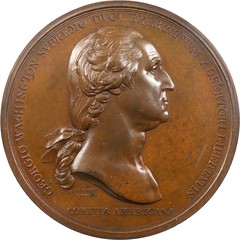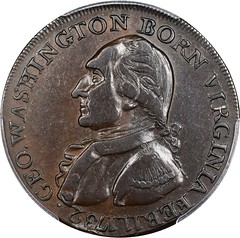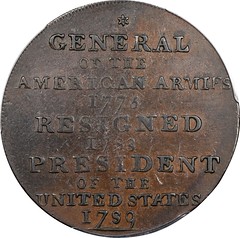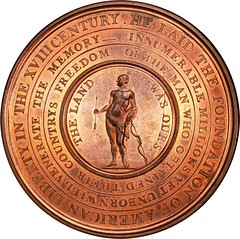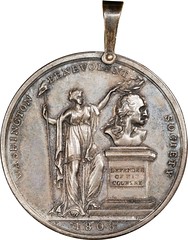
PREV ARTICLE
NEXT ARTICLE
FULL ISSUE
PREV FULL ISSUE
STACK'S BOWERS: JOHN PACK WASHINGTONIANAStack's Bowers will be selling the Washingtoniana from the John M. Pack Collection on November 12. Select items are discussed below. -Garrett
Undated (ca. 1777) Voltaire Medal. Musante GW-1, Baker-78B, Betts-544. Copper. AU-58 (PCGS). 39.9 mm. 333.1 grains. For most of the history of this medallic work, it has been misunderstood because the facts surrounding its genesis were seemingly masked. As a result, collectors have been left to their own imaginative devices. Though the medal was produced by a skilled hand, neither die bears the signature of an engraver. The assignment of a French origin is easy to apply based solely on the French language reverse inscription, but to this day, the source remains uncertain. The attribution of Voltaire as having some degree of authorship in the medal is another seemingly clear conclusion, as that same French-language legend is taken directly from his 1723 poem, La Henriade. The circumstances of Voltaire's life around the time of the issuance of this medal, however, make it quite unlikely that his hand was involved. Though it has long been accepted as the first portrait medal of Washington, the conspicuous fact that the portrait looks nothing like Washington has perplexed many collectors. Indeed, the Voltaire medal is shrouded in a degree of mystery that is difficult to accept as anything other than purposeful. Long housed in its original wooden box, the medal has been protected to a degree, but it is clear that over the centuries it has been handled, studied, shown and appreciated. There is no mistaking that. The largely deep brown surfaces are slightly worn, displaying pastel iridescence in the obverse fields while areas of the reverse have toned more deeply. Both sides are somewhat mottled, and the obverse exhibits some scattered handling marks. The box shows considerable age and handling, though it is perfectly intact. The manuscript paper label remains not only intact, but respectably legible for the 200 years of handling it has seen. Provenance: From the John M. Pack Collection. Earlier from Benjamin Franklin; presented by Franklin to Isaac-Jean-Georges-Jonas Grand ("Georges Grand") in Paris, 1778; gifted by Grand to the father of Jos. Cook, by 1793; Jos. Cook, by descent; unknown intermediaries; John Kraljevich Americana, December 2021.
To read the complete item description, see:
"1776" (ca. 1789) Washington Before Boston Medal. First Paris Mint Issue. First Issued "Original" Obverse / First Issued "Original" Reverse. Musante GW-09-P1, Baker-47B, Adams-Bentley 3. Bronze. Plain Edge. MS-63 BN (PCGS). 68.4 mm. 2149.6 grains. An exceptionally attractive example of this classic Washington medal, struck from relatively early state dies in a handsome composition. While some of the original Washington Before Boston medals come with a dark mahogany bronzed finish, this (and some others seen) were not bronzed, that treatment likely being applied to slightly later strikes from the dies intended specifically for sale to historical medal collectors. Since the original gold presentation medal was struck for Washington in 1789, it seems that the Washington Before Boston medal has been widely considered a prized possession. Early on, silver and bronze medals were likely distributed to participants in the Siege of Boston, their families, friends, and others who celebrated Washington's clever action atop Dorchester Heights, a pivotal and encouraging victory for the Continental Army that inspired the medal. The Washington Before Boston has stood the test of time as a lasting memorial to Washington and his broader success in the cause of the American Revolution. The medals have been in production to some degree ever since the originals like this were struck, or at least comfortably into the 20th century, by both the Paris Mint and the United States Mint. Collections can be made of just this medal (with all the variations), but originals, as here, from the original Paris Mint dies have always been the most beloved and sought after. Not surprising, as these were from the same dies that struck Washington's gold medal and are thus the tangible objects most closely related to the entire historic affair and the people involved-George Washington being central. From the John M. Pack Collection. Earlier from Baldwin's of St. James' Auction 37, September 2019, lot 574; Stack's Bowers Galleries, via direct sale, October 2019.
To read the complete item description, see:
"1789" (ca. 1792) Washington Born Virginia Copper. Legend Reverse. Musante GW-33, Baker-60, W-10730. Second Reverse. Copper. Plain Edge. EF-40 (PCGS). Aside from a small group of magnificent and extremely expensive Mint State pieces, most survivors are Very Fine and lower, and have such poor central detail that they are just outright undesirable examples of the type. This one is pleasant in every respect, with just a tiny rim bump noted at the lower obverse and a trivial nick at the N of BORN worthy of mention. According to direct communication with the former owner, this piece "represented the type in the family collection since probably the 1970s," until its sale in late 2023. From the John M. Pack Collection. Earlier from our sale of the E Pluribus Unum Collection, November 2023, lot 2149.
To read the complete item description, see:
1797 Presidency Resigned Medal. By Thomas Wyon. Musante GW-64, Baker-66. White Metal. AU-50 (PCGS). 37.6 mm. 391.9 grains. An interesting feature of this and other Wyon medals in this series (as well as the Twigg medals, GW-38), is the small irregularity struck into the center. It is occasionally on the obverse, but more frequently seen on the reverse, as here. This is the remnant of the casting sprue from when the cast planchets were produced. As such, these planchets were cast in a similar manner to how button manufacturers cast pewter buttons at the same time. This would be ideal for planchets to be struck, as a sprue on the edge would need to be filed off by the medallist, while a central sprue could be simply struck flat by the dies, reducing effort and production time. The Wyon piece that Baker cataloged as his B-66 is actually known in four different die combinations, there being three known obverse dies and two known reverse dies. These are described by Musante as GW-63, 64, and 65, with the fourth combination noticed by the present writer, represented by four examples including the Rulau-Fuld plate medal. Considering the multiple dies, the inexpensive composition and the softness of the metal (which would not have been particularly taxing on the dies) these medals are amazingly rare. At the time of writing, there are just five known of this variety. Two are very nice, two are very problematic and this pleasing one is the lone example in the middle of these extremes. These Wyon issues are among the toughest early Washington medals to find, particularly without serious flaws. From the John M. Pack Collection. Earlier ex John Kraljevich Americana, September 2023.
To read the complete item description, see:
1798 Washington Seasons Medal. The Home. Intermediate Reverse Die State. Musante GW-69, Baker-172A, Julian IP-52. Copper. Specimen-40 (PCGS). 48.2 mm. 722.7 grains. Though the Seasons medals do not bear a portrait of Washington, they are inextricably tied to him, his administration and his memory. The direct inspiration for the designs of these medals was from George Washington's own pen. On August 29, 1796, George Washington wrote a letter to the Cherokee Nation, the complete text of which is easily found on the website of the National Archives. The letter was meant to address relations with the Cherokee by way of instruction as to how they might improve their standing as peaceful neighbors of the white settlers. It is a fascinating read for its insights into Washington's thoughtful manner, but also into the decidedly inconsiderate and absolute approach the administration took toward Native peoples. Washington was specific and presented his own personal desires to retire to his plantation as guidance for how the Cherokee might best live in peace and prosperity. He described the advantages of expanding livestock and crops and that "your wives and daughters can soon learn to spin and to weave," relating directly to the presently offered medal. Your cataloger's years-long study of the Indian Peace medals has recorded 17 known examples of this medal in bronze. At least three were collector's strikes, and three more are in the museum holdings of the American Numismatic Society, Massachusetts Historical Society and Yale University Art Gallery. Again, among the 17, this is the only one known with its suspension loop intact. Acquired from a non-numismatic eBay seller in Virginia, and thus a relatively recent discovery. Offered here to a dedicated numismatic audience for the first time. From the John M. Pack Collection. Earlier via eBay, January 2019.
To read the complete item description, see:
"1799" (ca. 1800) Washington Funeral Urn Medal. Musante GW-70, Baker-166A, Fuld Dies 1-B. Silver. AU-58 (PCGS). The short window of time between Washington's passing, on December 14 and the first of the numerous funeral processions introduces a degree of wonderment that Perkins could accomplish so much engraving and striking of what appears to be a considerable number of these medals in time for the targeted events. While Washington died on the 14th, news of the day did not travel quickly, and yet, Perkins was advertising the medals for sale as early as January 3. With at least 14 dies having been individually hand-made, he must have devoted every waking hour to these issues from the time he learned the news to the time of sale. Unlike many Washington portrait medals, these were purpose driven, made specifically for display during Washington's funeral processions. As such, they are far more historic and significant than many of the other early Washington medals. From the John M. Pack Collection. Earlier ex F.C.C. Boyd estate; our (Stack's) sale of the John J. Ford, Jr. Collection, Part II, May 2004, lot 172; Lawrence R. Stack Collection, November 2006; our sale of the Sydney F. Martin Collection, November 2022, lot 2083.
To read the complete item description, see:
1800 Hero of Freedom Medal. Musante GW-81, Baker-79C. Bronze, Fire Gilt. MS-63 (PCGS). This was likely also struck over a cut down 1797 British penny. This has long been a favorite among the medals in this collection. From the John M. Pack Collection. Earlier ex Fred Baldwin; a "collection from the 1950s;" John Kraljevich Americana, December 2013.
To read the complete item description, see:
1803 Washington Fame Medal. Musante GW-87, Baker-84. Copper, Bronzed. Specimen-63 (PCGS). The Fame medal is widely considered to be the most beautifully styled of the early memorial medals. Since the early days of American numismatics, it has been prized. In the 1862 David McGilvray sale of coin dealer Henry Cook's property, a Fame medal was described as "the first offered at public sale in this country" and realized $37.50. The following year, and with the medal apparently newly known to American collectors, William Sumner Appleton paid $125 for his in Woodward's October 1863 sale. In 1864, the John McCoy specimen sold to J.N.T. Levick for $85, all substantial sums during the American Civil War. In 1882, one was given valuable space on the Bushnell catalog plate. The Fame medal was among the classic Washington pieces produced in England for sale into both European and American cabinets. Though long mis-attributed as to maker, this medal is clearly the work of John Gregory Hancock based on stylistic comparison. Other medals by Hancock produced in this era that share this style include such pieces as the Robert Banks Secretary of State medal of 1803 (BHM-548) and the 1806 Death of William Pitt medal (BHM-613). In addition to the notable provenance given below, extending back comfortably more than a century, this was plated in George Fuld's article, "Early Washington Medals" in the American Journal of Numismatics, Second Series #14, 2002, pg.139. This is one of just 23 examples recorded by the writer. From the John M. Pack Collection. Earlier ex S.H. Chapman's sale of the Henry L. Jewett Collection; June 1909, lot 425, at $5, to "C" which is "Chapman"; our (Bowers & Ruddy's) sale of the Stanley Scott Collection, June 1975, lot 470; unknown party to Jack Collins, privately, November 1988; our (Stack's) sale of the Jack Collins Sale, Part I, April-May 1996, lot 90; our sale of the Charles Wharton Collection, March 2014, lot 2108.
To read the complete item description, see:
1805 Eccleston Medal. Musante GW-88, Baker-85. Bronze. Specimen-64 RB (PCGS). The Eccleston medal is a classic early Washington piece and is beloved for its considerable size, elegant styling and still somewhat unexplained reverse design featuring a Native American and the legend, THIS LAND WAS OURS. The message here, coupled with the sentiments toward Washington, has been a matter of debate as to intent for a long time. Though it is frequently analyzed as sympathetic to the cause of the Native peoples who were becoming increasingly displaced, one must take care to not make judgements on early 19th-century motifs through the lens of the present. The general is cuirassed in grand form on the obverse, the unmistakable image of a victor. When coupled with the sentiment of the central reverse, it is worth acknowledging that Washington himself wrote to the Cherokee to recommend that they essentially learn to live as whites did, for their own prosperity. In 1805, the institution of slavery was legal in the United States and Great Britain, and the British Empire would continue to exploit as many territories and indigenous peoples as possible around the world for decades to come. Native American policy in the United States was no better. This said, the thoughts of any individual might differ vastly from societal norms en vogue at any given time, and the fact that the Native American would be acknowledged at all is probably highly significant. Unfortunately, Eccleston gave no clues in his own presentation letter that he sent to Thomas Jefferson with examples of the medal. In it he simply referred to the entire reverse as bearing "an American Indian with his bow and arrow, and an appropriate legend." This was amazingly one of nine Eccleston medals revealed in Part II of our sale of the John J. Ford, Jr. holdings-obviously a Ford favorite. It was the second Eccleston offered therein and the singular one chosen for the sale's color plates, in two different places, one being a full page devoted to it. Michael Hodder, in writing that sale, noted it to be "absolutely spectacular" and "the only one this cataloguer has ever seen with this degree of mint red remaining…the mint color lending a remarkable three-dimensionality to the piece." Two people have informed the writer that this is the only Ford sale lot the late esteemed dealer and large-cent collector Doug Bird bought, a notable fact. From the John M. Pack Collection. Earlier ex Fred Baldwin, June 1967; our (Stack's) sale of the John J. Ford, Jr. Collection, Part II, May 2004, lot 138; Doug Bird (said to be the only lot he bought from Ford); John Kraljevich Americana, November 2019, at the Baltimore Show.
To read the complete item description, see:
1808 Washington Benevolent Society Medal, Sash and Silk. Musante GW-94, Baker-327, Julian RF-23. Silver. Virtually Mint State. Contemporary newspaper reports on the public activities of the Benevolent Society occasionally specify that badges were to be worn through the upper left breast buttonhole. Presumably, the badges referenced were the silver medals of this type, engraved by Reich and struck at the U.S. Mint, as other contenders such as the silk ribbons that could have been referred to as "badges" would not make sense for such a point of fixture. This piece was clearly not worn in such a fashion, however. The mode of display was much more elegant and would have given much greater prominence to the person wearing this adornment. Most likely, a display of this manner would have been reserved for members of the society of some significant rank, or it would have been reserved for those serving as marshals leading processions of society members at public events. The society did parade at special occasions, often marking the birthday of Washington on February 22. Most of the Benevolent Society medals encountered are simply the round disc, often with the original suspension hanger lost. The intact hangers do not appear fragile, but some of these medals do seem to be somewhat hard worn. Occasionally a nice one is seen with a hanger, but evidence of some use is almost always visible. The writer has seen one very nice example with a plain black ribbon of some age, for suspension around the neck, but that was a single sighting. From the John M. Pack Collection. Earlier ex the J. Doyle DeWitt Collection; Heritage, by direct purchase; Heritage, October 2022, lot 43660, via John Kraljevich Americana.
To read the complete item description, see:
1824 Lafayette Visit Medalet. Likely by Charles James Joullain. Musante GW-112, Baker-198A. Silver. AU-50 (PCGS). Approximately 14.5 mm, without the loop. The vintage and purpose of these medals are undisputed. They were struck to mark the occasion of the Marquis de Lafayette's return to the United States for an American tour in 1824. He arrived on August 15 and across the next 14 months, he visited each State of the Union enjoying celebrity status and reverence at every turn. A wide array of objects was sold to mark his return tour, including medals, thematic gloves, badges, belts, combs, chains, socks, silks and other goods. Formal engagements included visits to Mount Vernon, a Congressional Banquet, a reception at the White House and others. A Grand Fete at New York's Castle Garden was advertised for September 10, and a "Grand Jubilee" in Philadelphia for October 4. Though a French National, his celebrity in the United States was substantial in an era when elder Americans could recall the days of the Revolution. Probably only the memories of Washington and Franklin were dearer to average citizens. The matter of who made these medals has long presented quite the opposite situation. Since the time of the Civil War, these medals have mostly been attributed to Charles Cushing Wright, a resident of New York in 1824, and business partner (circa 1823-1827) of Asher B. Durand. Durand was a prominent copper and steel plate engraver and, later, painter of the Hudson River School. Wright was a highly skilled medallic engraver, though not known to have been prolific at this early year in his career. Both men were central figures in the establishment of the National Academy of Design a few years later. Durand and Wright engraved and printed the admission tickets to the Castle Garden Grand Fete. Advertising of James D. Stout of New York on September 9, 1824, offered commemorative gloves bearing an engraved portrait of Lafayette by C.C. Wright. From the John M. Pack Collection. Earlier ex Henry Chapman's sale of the Captain Andrew Zabriskie Collection, June 1909, lot 122, at $4, plated, with jump ring, since removed; The United States Coin Company's (Wayte Raymond) sale of the Judson Brenner Collection, June 1916, lot 57, at $3; unknown intermediaries; John Kraljevich Americana, privately, February 2013.
To read the complete item description, see:
1856 Buchanan & Breckinridge Campaign Medal. The "Buck-Cannon" Rebus Medal. Musante GW-155, Baker-380A, DeWitt-JB 1856-2. White Metal. MS-65 (NGC). 46.2 mm. Our online archives include just four examples of this medal in this composition. The date of issue and reverse design tie this medal to the Presidential campaign of James Buchanan and his running mate John C. Breckenridge through a cleverly designed and memorable rebus representing Buchanan through the depiction of a buck and a cannon in a field of 32 stars. Musante points out regarding these stars that they "probably showed the candidate's support for admitting Minnesota to the union as the thirty-second state." Minnesota became the 32nd state during their administration, in 1858. From the John M. Pack Collection. Earlier from our sale of the John J. Ford Collection, Part XXIII, August 2013, lot 21316.
To read the complete item description, see:
1862 District of Columbia Emancipation Badge. GRATE JOY TO OUR RACE. Musante GW-566, Baker-620B, Meier-Stahl 3C. Brass, Gilt. MS-61 (PCGS). 31.0 mm. It is widely known that Abraham Lincoln signed the nation-wide Emancipation Proclamation on January 1, 1863. It is also widely recognized that Emancipation was finally ordered in Texas on June 19, 1865-an action celebrated as the end of slavery in the United States and acknowledged by a federal holiday to this day in Juneteenth National Independence Day. What is not widely known is that Emancipation came first to the city of Washington, D.C., on April 16, 1862, through The D.C. Compensated Emancipation Act. It seems that the District of Columbia was singled out after successful abolitionist efforts by Massachusetts Senator Charles Sumner to alert Lincoln that he, as the Chief Executive of the federally administered District of Columbia, held the power to unilaterally free all the enslaved persons in the District. The effective argument had been made that having that opportunity but not taking advantage of it was tantamount to being the slaveholder directly-and the largest in the nation. There were 3,100 enslaved persons in Washington freed by the action and, naturally, there was great enthusiasm and encouragement felt among local African Americans as well as the broader abolitionist community, well beyond the confines of the District of Columbia. The more specific history of these remains uncertain, as we have only the few badges themselves and the names known to have been punched into some of them as evidence to work from. While it has long been believed that these are the names of former slaves and that these were made in celebration immediately upon the signing of the Act in 1862, it is the opinion of the writer that a more likely scenario is that all of these badges were produced and sold at an event such as the 1866 Emancipation Parade referenced above. They would be no less significant as such. The Grate Joy type was likely prepared in advance for sale, while the named medals were probably punched to order on site-just as the soldier's identification badges had been during the war. Being personalized, they were likely more widely desired and sold in somewhat greater number. From the John M. Pack Collection. Earlier from an unidentified New England Family, via eBay, June 2018.
To read the complete item description, see:
Wayne Homren, Editor The Numismatic Bibliomania Society is a non-profit organization promoting numismatic literature. See our web site at coinbooks.org. To submit items for publication in The E-Sylum, write to the Editor at this address: whomren@gmail.com To subscribe go to: Subscribe All Rights Reserved. NBS Home Page Contact the NBS webmaster 
|


